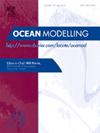波致混合对气候模式中上层混合层模拟的影响
IF 2.9
3区 地球科学
Q2 METEOROLOGY & ATMOSPHERIC SCIENCES
引用次数: 0
摘要
上层海洋在大气-海洋耦合系统中起着至关重要的作用。波浪引起的垂直混合显著影响上层海洋的结构,这对气候预测至关重要。本研究评估了LICOM模式对上层海洋模拟的偏差,并采用非破碎波诱导混合的参数化方案,将WAVEWATCHIII波模式导出的波诱导混合系数Bv纳入其中。将该系数整合到LICOM模式的垂直混合方案中,以评估对上层海洋模拟的影响。结果表明:波浪引起的混合作用增加了混合层深度(MLD),降低了海表温度(SST),增强了垂直混合作用,导致上层海洋温度降低,而次表层温度升高。Argo观测数据和EN4数据产品的验证表明,考虑波浪引起的混合可以改善模拟的MLD、SST和上层海洋温度气候学,使它们与观测值更接近。因此,加入波致混频可以提高LICOM模型的预测能力。本文章由计算机程序翻译,如有差异,请以英文原文为准。
The impact of wave-induced mixing on the simulation of the upper mixed layer in climate models
The upper ocean plays a critical role in the atmosphere-ocean coupled system. Wave-induced vertical mixing significantly influences the structure of the upper ocean which is crucial for climate predictions. This study evaluates the biases in the LICOM model’s simulation of the upper ocean and incorporates the wave-induced mixing coefficient Bv, derived from the WAVEWATCHIII wave model using a parameterization scheme for non-breaking wave-induced mixing. This coefficient was integrated into the vertical mixing scheme of the LICOM model to assess the impact on upper ocean simulation. The results indicate that wave-induced mixing increases the mixed layer depth (MLD) and decreases the sea surface temperature (SST), enhances vertical mixing, and leads to a decrease in upper ocean temperature while increasing subsurface temperature. Validation with Argo observations and the EN4 data product demonstrates that considering wave-induced mixing improves the simulated MLD, SST, and upper ocean temperature climatology, aligning them more closely with observed values. Consequently, incorporating wave-induced mixing can enhance the predictive capabilities of the LICOM model.
求助全文
通过发布文献求助,成功后即可免费获取论文全文。
去求助
来源期刊

Ocean Modelling
地学-海洋学
CiteScore
5.50
自引率
9.40%
发文量
86
审稿时长
19.6 weeks
期刊介绍:
The main objective of Ocean Modelling is to provide rapid communication between those interested in ocean modelling, whether through direct observation, or through analytical, numerical or laboratory models, and including interactions between physical and biogeochemical or biological phenomena. Because of the intimate links between ocean and atmosphere, involvement of scientists interested in influences of either medium on the other is welcome. The journal has a wide scope and includes ocean-atmosphere interaction in various forms as well as pure ocean results. In addition to primary peer-reviewed papers, the journal provides review papers, preliminary communications, and discussions.
 求助内容:
求助内容: 应助结果提醒方式:
应助结果提醒方式:


